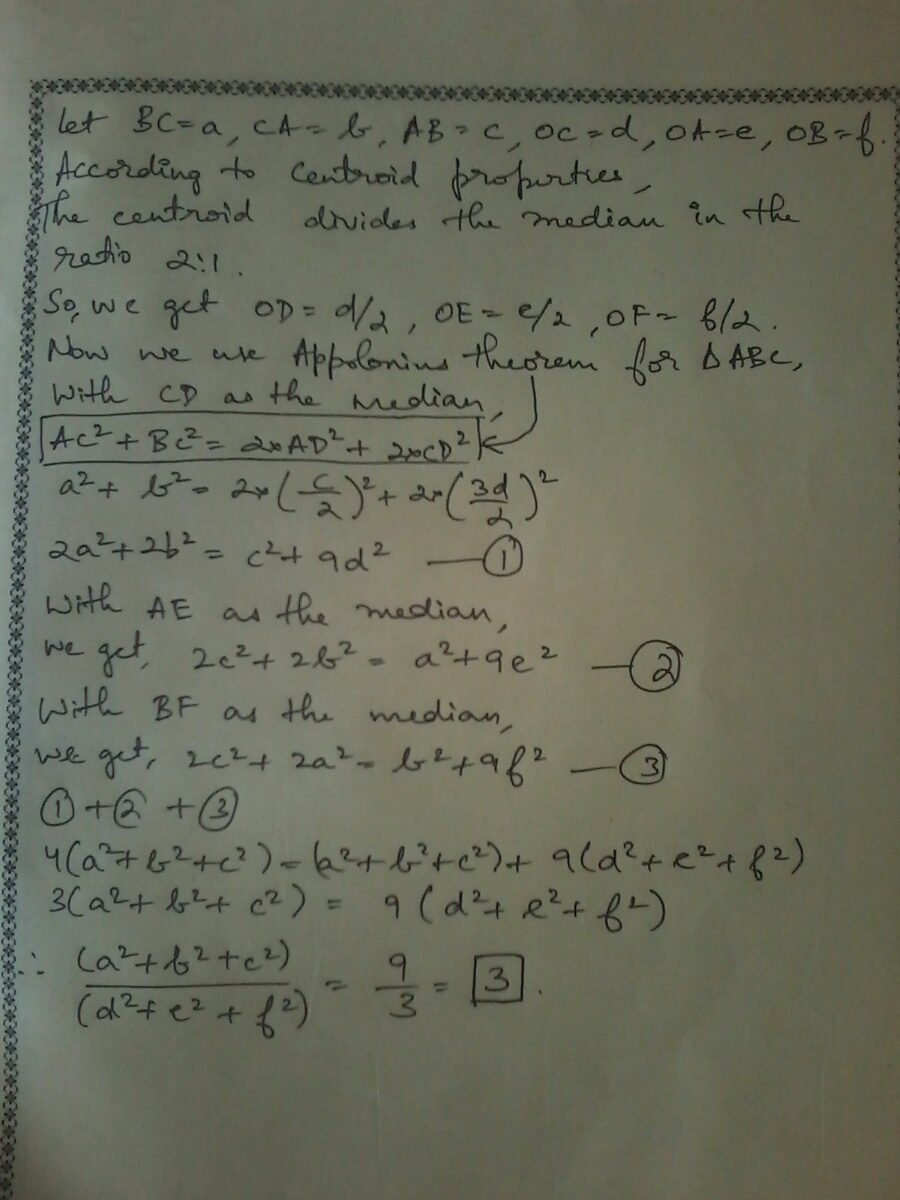Triangle Centroid
Let a , b , c be the side lengths of triangle A B C above, and let d , e , f be the distances from its centroid O to the vertices. (The red lines are the medians.)
What is the ratio d 2 + e 2 + f 2 a 2 + b 2 + c 2 ?
The answer is 3.
This section requires Javascript.
You are seeing this because something didn't load right. We suggest you, (a) try
refreshing the page, (b) enabling javascript if it is disabled on your browser and,
finally, (c)
loading the
non-javascript version of this page
. We're sorry about the hassle.
2 solutions


Oh yes. Exactly I did. Btw I like your paper's border :p
Log in to reply
hahaha.thanks.Its a scrap book.
good solution
+1 Nice use of apollonius theorem .
Vectors prove to be convenient in this problem.
Let u = A B and v = A C
and let a = ∣ B C ∣ , b = ∣ A C ∣ = ∣ v ∣ , c = ∣ A B ∣ = ∣ u ∣
and let d = ∣ O A ∣ , e = ∣ O B ∣ , f = ∣ O C ∣
Then
A O = 3 1 ( u + v ) ⋯ ( 1 )
O B = u − A O = 3 2 u − 3 1 v ⋯ ( 2 )
and
O C = v − A O = 3 2 v − 3 1 u ⋯ ( 3 )
In addition,
B C = u − v ⋯ ( 4 )
Now using the length formula for a vector, and equation (1), we have
d 2 = 9 1 ( u ⋅ u + v ⋅ v + 2 u ⋅ v )
but u ⋅ u = c 2 and v ⋅ v = b 2
Hence,
d 2 = 9 1 ( c 2 + b 2 + 2 u ⋅ v ) ⋯ ( 5 )
similarly, we obtain from equations (2) through (4), the following,
e 2 = 9 1 ( 4 c 2 + b 2 − 4 u ⋅ v ) ⋯ ( 6 )
and
f 2 = 9 1 ( c 2 + 4 b 2 − 4 u ⋅ v ) ⋯ ( 7 )
and finally, from equation (4) , we have
a 2 = b 2 + c 2 − 2 u ⋅ v ⋯ ( 8 )
Adding equations (5) through (7), we get
d 2 + e 2 + f 2 = 9 1 ( 6 b 2 + 6 c 2 − 6 u ⋅ v ) ⋯ ( 9 )
Using equation (8) to replace the last term, we get
d 2 + e 2 + f 2 = 9 1 ( 6 b 2 + 6 c 2 + 3 ( a 2 − b 2 − c 2 ) )
which becomes,
d 2 + e 2 + f 2 = 3 1 ( a 2 + b 2 + c 2 ) ⋯ ( 1 0 )
So that finally, we have
d 2 + e 2 + f 2 a 2 + b 2 + c 2 = 3